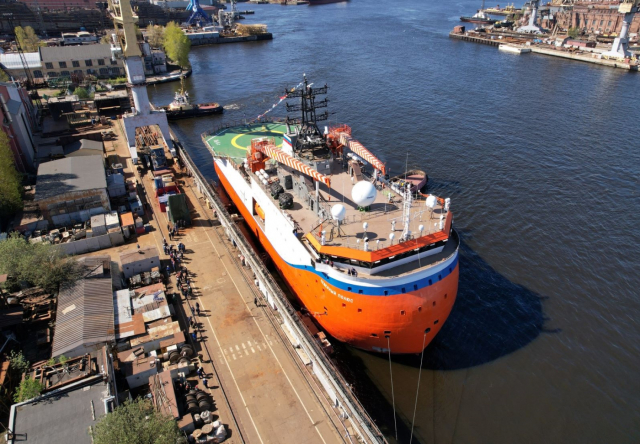As reported by JSC United Shipbuilding Corporation (USC), on August 24, 2022, Admiralty Shipyards JSC, which is part of it, handed over to the Federal Service of Russia for Hydrometeorology and Environmental Monitoring (Roshydromet) a scientific expedition vessel, the ice-resistant self-propelled platform "North Pole" of project 00903 (factory number 02404). The ship, moored from the completion embankment of the enterprise, went to the Big Port of St. Petersburg. Here, the ice-resistant self-propelled platform will be prepared for the transition to Murmansk and then - for the first research expedition.

The ice-resistant self-propelled platform "North Pole" of project 00903 (factory number 02404), built at JSC Admiralty Shipyards, has been put into operation. St. Petersburg, 24.08.2022 (c) Admiralty Shipyards JSC Recall that on March 30, 2018, a Decree of the Government of the Russian Federation and an order of the Government of the Russian Federation were signed, which approved the design and construction of an ice-resistant self-propelled platform (LSP)
The North Pole is a floating observatory for Russian research and monitoring of the natural environment for Roshydromet. The date of commissioning of the platform was set for 2020. These documents approved the decision on budget investments in 2018-2020 in the design and construction of the platform in the amount of 6.9666 billion rubles, and JSC Admiralty Shipyards (St. Petersburg) was identified as the contractor for the design and construction of the platform. The developer of the project was JSC "KB "Vimpel".
The contract between JSC Admiralty Shipyards and Roshydromet for the design and construction of the ice-resistant self-propelled platform "North Pole" was signed in April 2018. According to the terms of the contract, the vessel was to be handed over to the customer at the end of 2020. The ceremony of the start of construction of the ice-resistant self-propelled platform "North Pole" (factory number 02404) was held at JSC "Admiralty Shipyards" on December 21, 2018. The official laying ceremony of the platform was [...] held there on April 10, 2019, and the launch took place on December 18, 2020.
Already in May 2020, it became known that the deadline for the delivery of the platform was shifted by two years - to the end of 2022, and the cost of construction, including due to the adjustment of contract parameters by the customer, will increase by 2-2.5 billion rubles. In this regard, in July 2021, by order of the Government of the Russian Federation, additional budgetary allocations in the amount of 1.082217 billion rubles were allocated to Roshydromet from the reserve fund of the Government to complete the construction of the LSP. In fact, the platform entered factory sea trials on May 21, 2022.
The all-season research platform with the functionality of a research center, which has no analogues in the world, is designed for year-round comprehensive scientific research in the high latitudes of the Arctic Ocean. The vessel will be able to conduct geological, acoustic, geophysical and oceanographic observations, move in the ice without the involvement of an icebreaker, receive heavy helicopters such as Mi-8AMT (Mi-17) or Mi-38. The implementation of wintering while maintaining comfortable and safe working and living conditions at the polar station is possible at temperatures up to -50 C.
Design characteristics of the LSP: length - 83.1 m; width - 22.5 m; displacement - about 10,390 tons; EC power - 4200 kW; speed - at least 10 knots; fuel reserve autonomy - about 2 years; service life - at least 25 years; crew - 14 people; scientific staff - 34 people. The ice-resistant self-propelled platform "North Pole" is built for the class of the Russian Maritime Register of Shipping: KM(*) Arc5[1] AUT1-C HELIDECK-F Special purpose ship, while the strength of its hull is designed for class Arc8. It is reported that this implies the possibility of year-round operation in the Arctic and moving to the home point both by independent navigation and under the guidance of an icebreaker. The permissible thickness of the ice in which the LSP is able to go in the channel behind the icebreaker at low speed in the winter-spring period is up to 0.8 meters, and in the summer-autumn up to 1.2 meters. When swimming independently in thin annual ice up to 0.8 and up to 1 meter, respectively.
As the main engine on the LSP, a medium-speed non-reversible diesel engine with turbocharging and charge air cooling Wartsila with a capacity of 4200 kW is used. The LSP electric power plant includes three auxiliary Wartsila diesel generators with a capacity of 800 kW and one emergency generator with a capacity of 300 kW. Also on the platform there is an auxiliary boiler plant implemented by two thermal boilers with a capacity of 1500 kW each. The minimum power of the propellers for the Acr5 class is provided by a full-turn screw steering column of the Russian company MSS with a fixed-pitch screw with a capacity of 3500 kW and a bow thruster of a water jet type with a capacity of 1200 kW.
At a distance of up to half a kilometer from the ship, a mobile field camp can be set up on the drifting ice, where scientists can carry out research in the natural environment. For polar explorers, up to 20 laboratory houses can move from the ship to the ice, as well as four snowmobiles, one snowmobile and two DT-75 tractors.
